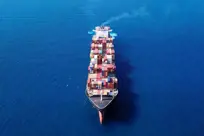
No more stowaways in cargo ships’ ballast water
Ballast water is crucial to the safety of a ship, but uncontrolled discharge wreaks havoc on the world’s ecosystems. A recently adopted convention on ballast water will introduce added control measures, and now 35,000–40,000 cargo ships will have to install a purification system to meet the stricter requirements.
Each year around the world, between five and ten billion tonnes of water are transported from one sea to another. This happens because countless commercial vessels travel from sea to sea, and they regulate their depth and stability by sucking in and releasing ballast water in and out of their enormous tanks.
Now, however, the newly adopted Ballast Water Management Convention will shut off the uncontrolled ballast tap in vast swaths of the world. The environment pays a high price for these discharges which can contain invasive microorganisms, and commercial vessels around the world must therefore install purification systems and take greater responsibility for their ballast water.
Rasmus Folsø, CEO, Desmi Ocean Guard, is an expert in ballast water management and is looking forward to the new regulations.
“It’s good news because invasive species can bring about immeasurable environmental changes. Once a species has been introduced in a new ecosystem, it’s basically impossible to get rid of it. That’s why the new legislation is an important step towards limiting the adverse environmental impacts,” Rasmus Folsø says.
New purification system to be installed on up to 40,000 ships
Up until now, roughly 95% of the world's ships have been sailing without ballast water management, but on 8 September 2017 that is all over. With Finland's approval of the IMO’s International Convention for the Control and Management of Ships’ Ballast Water and Sediments from 2004, the agreement now has the backing of 52 countries, which is enough for it to enter into force and tighten up the requirements for managing ballast water on a global level.
Over the next five years, all ships on international routes will be obligated to install a special purification system for ballast water emissions in order to meet the established standards for certification and quality control. Between 35,000 and 40,000 ships are expected to receive comprehensive hull installations.
“There are more than 60 type-approved purification systems, but the two most widely used systems are either based on chemical purification or a two-step process with mechanical filters and UV light. In the vast majority of cases, the purification system will be installed in the engine room, but on existing ships where space is scarce, it’s possible to install a special deckhouse for this purpose," Rasmus Folsø explains.
Opening up a huge market
With the new emission requirements, suppliers and service companies involved with ballast water can look forward to being very busy in the wake of the new convention.
“It’s a huge market that will be opening up over the next five to six years for suppliers of equipment and purification solutions, such as mechanical filters and UV units. We also expect to see a rising demand for professional expertise in areas like design, installation and service for the new equipment, on both existing ships and new builds,” says Rasmus Folsø, who continues:
"Manufacturers of diesel generators may also experience rising demand because ships in certain situations will require additional electrical power to be able to operate the large purification systems, which, depending on the model, can process anywhere from fifty to several thousand tonnes of water per hour.”
This is also good news for many Danish maritime subcontractors, which are some of the most advanced in the environmental market. Among these is Hoyer, which supplies marine electric motors used for things like the many back-flush pumps that move enormous volumes of water through the purification systems.
Facts about the Ballast Water Management Convention
- Enters into force worldwide on 8 September 2017
- Establishes legal limits for organism concentrations and rules for managing sediment in ballast water.
- Applies as a general rule to all ships that discharge ballast water.
- Ships that only travel within their respective national waters are usually exempt.
- Ships transiting through fixed routes near the coast or those sailing within a set area can apply for a dispensation based on a risk assessment documenting a low level of risk. An assessment of the so-called 'same risk area' is performed using guidelines drawn up by the UN’s International Maritime Organisation (IMO).
- Ships built after 8 September 2017 must be fitted with ballast water management systems. The installation deadlines for ships built before that date have yet to be determined. The topic will be discussed by the IMO’s Marine Environment Protection Committee (MEPC) in July 2018.

